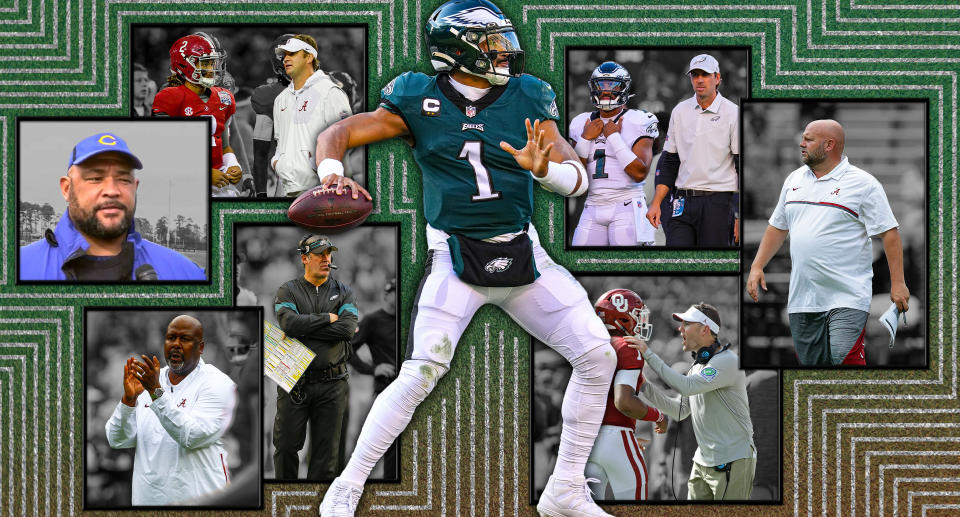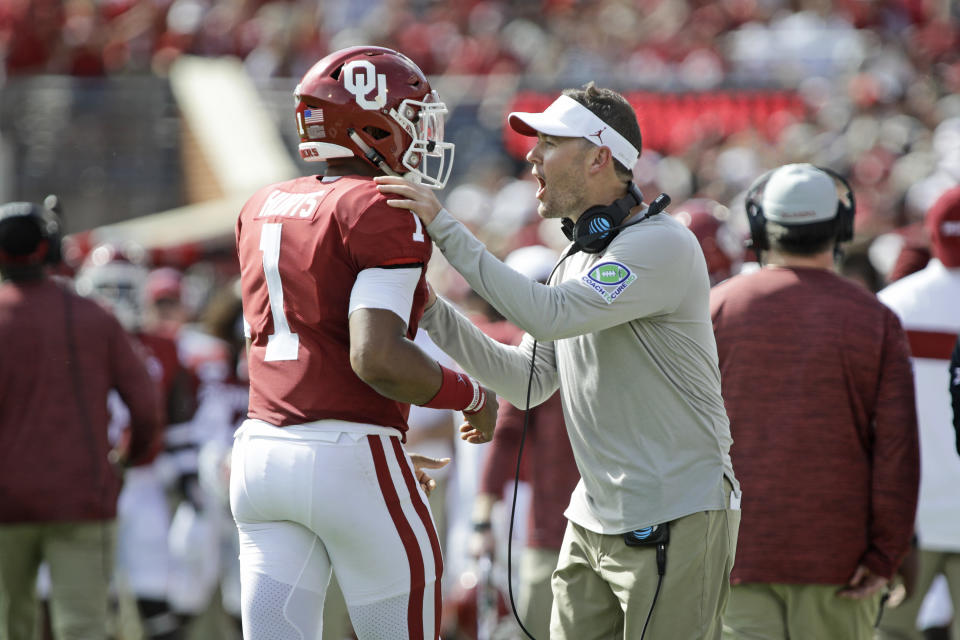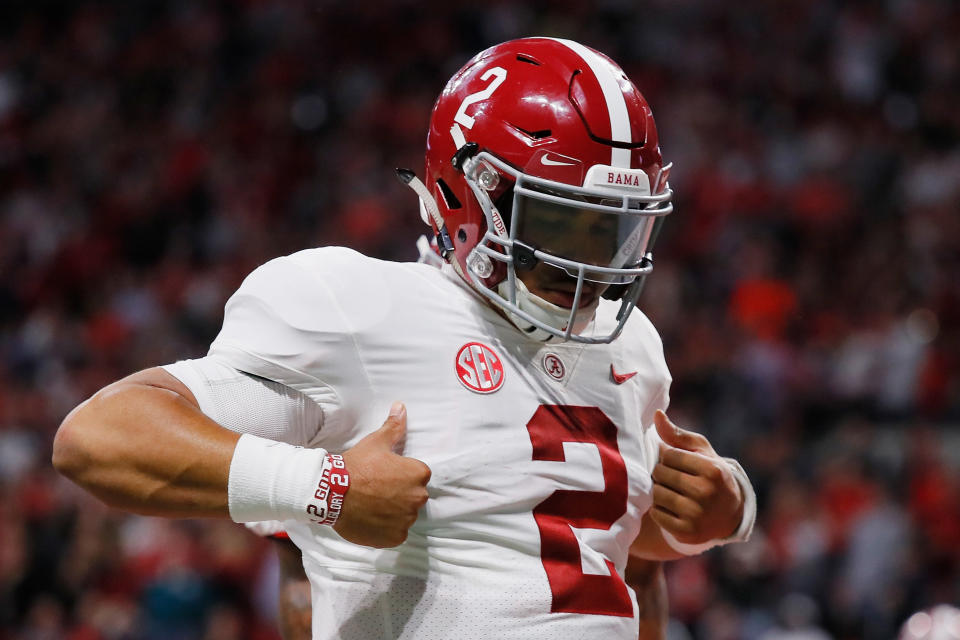Lincoln Riley understood the questions.
He didn’t, however, know the answers.
The 2020 NFL draft neared and scouts toiled to understand: How good could quarterback Jalen Hurts be? And how should they even assess a guy like this?
The journey Hurts had traversed was rare, if not unprecedented. He was emerging from Year 5 of what would become seven straight seasons with a different play-caller. Riley understood the challenge that posed, even as Hurts threw 32 touchdowns to 8 interceptions and rushed for another 20 scores in their lone season together at Oklahoma.
Hurts had showcased plenty — and yet, it seemed layers of potential remained untapped.
“Every question from every team was, ‘How do you project this guy?’” Riley, now USC’s head coach, told Yahoo Sports in a recent interview. “I told them, ‘I think he’s going to be a really good player. He’s got a pro mentality. But I don’t know where his ceiling is.’”
Riley’s final insight: “If he ever gets continuity in the system — watch out.”
In Hurts’ third professional season, NFL teams are learning to heed that advice.
For the first time since playing for his father in high school, the Philadelphia Eagles quarterback is reaping the benefits of a second year with the same play-caller. In concert, he has elevated his game to the level of an MVP candidate (only Kansas City Chiefs quarterback Patrick Mahomes has better odds, per BetMGM) with 29 total touchdowns to just three interceptions. His 108.3 passer rating ranks third-best in the league.
“Every play comes down to the decision-making,” Hurts said. “Defenses disguise, they give great looks, they have great players that are disruptive and kind of break plays sometimes. You have to be able to react to those unique looks and kind of make it work.”


Improved weapons, exceptional roster management and smart coaching undoubtedly contribute to the Eagles’ NFL-best 11-1 start. But Hurts is leading the charge. NFL and college football coaches, coordinators and quarterbacks insist the power of continuity in a system cannot be underestimated. Even for sharp-minded, quick learners — which Hurts is, in the eyes of those close to him — the drain of relearning an offensive system, terminology and play-calling rhythm can’t help but impact a quarterback’s development and execution.
“It’s like learning a new language,” Matthew Stafford, who quarterbacked the Los Angeles Rams to the Super Bowl in his first year in Sean McVay’s system, told Yahoo Sports. “The biggest thing you want to do as a quarterback is feel like you could teach it to everybody out in the huddle if you needed to. When it’s new every year, that becomes more and more difficult. But it also gives you a lot of exposure.”
Therein lies the paradox: While NFL talent evaluators generally believe the constant turnover muddies progress and execution in the moment, they simultaneously believe it can favor the shuffled quarterback if he withstands the tide until he ultimately reaches continuity.
Behold: faster play.
“The more you see, the more you play, the more experiences you have, your accelerated vision is going to pick up,” said Philadelphia offensive coordinator Shane Steichen, Hurts’ current play-caller. “And that’s what he’s been doing.”
But how exactly have Hurts’ former stops shaped him? Yahoo Sports tracked down coaches from Hurts’ myriad systems to understand.
The root of Jalen Hurts’ versatility
Entering freshman year of high school, Averion Hurts says, Jalen didn’t want to play quarterback.
“Well, who’s going to throw the ball to you?” the Channelview High School head coach, also Jalen’s father, responded.
So Jalen Hurts began throwing the ball for Channelview, earning his place as varsity full-time starter as a sophomore. He flashed that year, but “made the biggest jump” as a junior, Averion said. Concepts and play-calls began clarifying, the game slowing down as Jalen’s mind sped up. High school defenses were more predictable to dissect than the college and NFL ones he would later encounter, but Jalen nonetheless took control of his father’s Air Raid system, mastering the reads so well that by senior year, he could finish the play-calls his father began.
“He’d watch film on his own and he really had the ability to digest things we were saying at a high level and get an understanding of it,” Averion told Yahoo Sports by Zoom.
Hurts favored his legs effectively and often, scoring almost as much by ground (44 times) as by air (47) in his upperclassmen years. Rivals ranked Hurts as the No. 9 dual-threat quarterback in the Class of 2016. Offers came from 19 schools including the SEC’s Alabama, Texas A&M and Mississippi State. (Coincidentally, current Eagles quarterbacks coach Brian Johnson recruited him to the latter.)
Hurts chose Alabama, enrolled early in January and began learning the offense well enough to beat out teammates for the starting role as a freshman. Questions about his passing would come. His father would scoff.
“You’re saying that Nick Saban couldn’t judge a kid if he can throw or not?” Averion said of the seven-time national champion Alabama head coach. “You’re saying Lincoln Riley couldn’t judge a kid if he could throw or not?
“Sometimes in life, you get narratives put on you of what you can’t do. So if you know a person, you’re like, ‘Well, that’s not accurate.’”


New year, new game plan
All three of Hurts’ Alabama play-callers have since become head coaches. Current Ole Miss coach Lane Kiffin coordinated Hurts’ freshman year offense in 2016, while current New York Giants coach Brian Daboll — whom Hurts faces this weekend in an important NFC East game — took the helm in 2017. By 2018, current Maryland head coach Mike Locksley was calling plays.
The system evolved each year. Luckily for Hurts, Saban prevented a complete upheaval and reintroduction by requiring verbiage to carry over.
“You basically take what they’ve done there well and that stays, and then what they don’t have and you can add from your system,” Locksley said. “Kind of like gumbo.”
Kiffin brought a run-heavy system from USC, emphasizing play-action passes, bootlegs and naked bootlegs. Zone reads and power zone reads capitalized on Hurts’ athleticism, Kiffin bringing no-huddle philosophies to further stress the defense. Hurts threw for 2,780 yards, 23 touchdowns and nine interceptions, with another 13 scores on the ground. He became the first true freshman since Herschel Walker to win SEC Player of the Year as he quarterbacked Alabama to the national championship game. Hurts rushed for a 30-yard go-ahead touchdown with 2:07 to play before Clemson scored to win the game with 1 second to play.
“We talk about dual-threat, but I like to call it triple-threat,” Hurts said. “You have to be able to kill them with your legs at times, make the throws when you need to in the passing game, and kill them with your mind, and what you see and how you react.”
That triple threat helped him adapt when Daboll arrived in 2017 armed with pro-style concepts from his 17 seasons as an NFL assistant, including 11 in New England. Daboll blended the Patriots’ drop-back passing attack with the quarterback runs and zone-read game with which Hurts had already found success. Hurts played a clean, if less explosive, season; he threw 17 touchdowns to just one interception while rushing for eight scores. He famously was pulled in the national title game in favor of now-Miami Dolphins quarterback Tua Tagovailoa, who would become the Crimson Tide’s starter in 2018.
It was then that Locksley, on staff the prior two years, became coordinator. His goal: add pre-snap and post-snap run-pass option concepts to complete the system he believes Kiffin and Daboll had effectively advanced. Concepts favoring Tagovailoa’s big arm entered the conversation, Hurts developing his fundamentals with quarterbacks coach Dan Enos. Locksley installed an “Aqua” package featuring the quarterbacks simultaneously, in addition to reviewing concepts for Hurts before each game in case he was needed in relief.
In the SEC championship game, Hurts was. He’d ultimately score the winning touchdown on a 15-yard quarterback draw with an RPO attached to it, telling Locksley over the headset, “Give me that ‘Breeze’ s***. I like that ‘Breeze’ s***” when the play-caller asked the quarterback his red-zone preference. But Locksley emphasizes how Hurts’ legs simply finished the job his arm had done.


Hurts completed 7 of 9 passes for 82 yards and a touchdown in his fourth-quarter action, beginning with a key strike down the middle of the field in traffic to convert on third-and-12. That would define his conference championship-clinching performance: four third-down pass attempts, four completions, for 54 yards and a touchdown.
“Third-down throws that were tight-window, picture-perfect, pinpoint accuracy,” Locksley said. “And then the play that he scored on was a play that he asked for.”
Transferring to Oklahoma for his senior year enabled Hurts to start but also required he start over, as Riley’s Air Raid system was familial to his father’s high school concepts albeit more advanced. New terminology, new personnel, new movement keys. Riley encouraged him to loosen up on and off the field, hoping a more relaxed Hurts would prompt a freer-flowing offense. He understood the mindset shift required could complicate communication of calls, check identifications and confidence to release the ball.
Hurts simply got to work. He would finish second in Heisman Trophy voting to then-LSU and now-Cincinnati Bengals quarterback Joe Burrow. Hurts accounted for a career-best 57 total touchdowns and 5,174 yards from scrimmage.
Dallas Cowboys receiver CeeDee Lamb, Hurts’ close friend and teammate at Oklahoma, caught 14 of those touchdowns.
“His deep ball is a lot better than a lot of people give him credit for,” said Lamb, who caught Baker Mayfield and Kyler Murray’s passes the two prior seasons with the Sooners. “His mechanics, his ability to read. Then obviously everybody knows about his ability to run, but he doesn’t want to run unless he’s given the opportunity. If he has to run, he’s going to run with no hesitation.
“That’s what you like: dual threat, he wants to win, a winner.”
Shattering the ceiling
Not every NFL team agreed with Lamb’s evaluation of Hurts, one team evaluator telling Yahoo Sports “there was a ceiling put on him as a passer” in the pre-draft evaluation process. The evaluator spoke on condition of anonymity because they were not publicly authorized to disclose their team’s scouting report.
Nearly three full seasons later, that same evaluator characterizes league sentiment as “amazed” by the extent of Hurts’ progress as a passer.
Hurts started just four games as a second-round rookie under play-calling head coach Doug Pederson in Philadelphia, earning the full-time starter role last season with Steichen coordinating and calling plays. This year, his first season with a repeat play-caller since 2015, his growth is undebatable.
Hurts is completing 6.8% more passes than last season, and is on pace for 28.5 touchdowns (the half-touchdown is extremely unlikely, per Yahoo Sports research) with 4.2 interceptions (again, we’ll wager this will round to a whole number) compared to last year’s 16-to-9 ratio. Only Tom Brady, with a 0.6% passing interception percentage, has been cleaner.
Locksley, who says he’s still in touch with Hurts on a weekly basis, believes Hurts could always throw but now his mind can more often work with rather than against his ability. Locksley considers Hurts’ anticipatory throws, which require a quarterback to target a tight window before the weapon is open, his No. 1 area of growth. Eagles coaches laud Hurts’ checks at the line of scrimmage, his use of feet and eyes to manipulate defenders, and his increasingly sudden grasp of varied NFL defensive looks.
“What Jalen’s done well,” Eagles head coach Nick Sirianni said, “is just continuing to progress as a quarterback of knowing where to go with the football versus every different look.”
Sometimes game plans and decision-making demand he take off and run, like the Eagles’ Nov. 27 win over the Green Bay Packers in which he rushed for 157 yards. Other times, he’ll destroy opponents by air, as in the Eagles’ most recent game: a 35-10 win vs. the Tennessee Titans in which Hurts completed 74.4% of his passes for a career-best 380 yards and three touchdowns.
No NFL quarterback had previously thrown for 300-plus yards the game after rushing for 150.
No quarterback previously arrived in the NFL with quite the skills, game approach and especially the journey through systems and styles that Hurts has traveled on his path to becoming Philadelphia’s lethal threat.
“I think the big thing about playing the position and playing this game is it’s a lot of reaction-based,” Hurts said. “It’s not what happens to you, it’s about how you react to it.
“I try to learn from everything. Remain consistent and use all these formative experiences, all these things I’ve been able to experience and endure, and just learn.”
Follow Yahoo Sports’ Jori Epstein on Twitter @JoriEpstein
